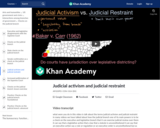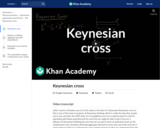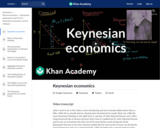
Video Marbury v Madison from Crash Course History
- Subject:
- Social Science
- Material Type:
- Lesson
- Date Added:
- 07/22/2024

Video Marbury v Madison from Crash Course History

Using Baker v. Carr to discuss judicial activism versus judicial restraint.

The purpose of this lesson is to teach students about the significance of the Judiciary Act of 1789 in establishing a federal judiciary, and the power of judicial review as outlined by the landmark U.S. Supreme Court Case, Marbury v. Madison (1803). By the conclusion of this lesson, students will understand the key provisions of the Judiciary Act of 1789 and the structure of the federal judiciary, as well as the power of judicial review.

In this lesson, students learn about the Sixth Amendment's guarantee of the right to a trial by an impartial jury chosen from a cross-section of the community. Students explore how this right has not always been protected when potential jurors were excluded because of their race, ethnicity, and gender. Access to this resource requires a free educator login.

In Katzenbach v. Morgan (1966), the United States Supreme Court ruled that Congress had not exceeded its authority when crafting Section 4(e) of the Voting Rights Act of 1965, which extended voting rights to a group of voters who had been turned away at the polls because they could not pass literacy tests. The case hinged on the Supreme Court’s interpretation of the Enforcement Clause of the Fourteenth Amendment.

Katz v. United States (1967) asked the Supreme Court to decide whether wiretapping a public phone booth requires a search warrant. The Court found that an average person has an expectation of privacy while making a call in a public phone booth. As a result, agents violated the Fourth Amendment when they used electronic surveillance to listen in on a suspect without a warrant.

Key constitutional concepts video that covers Articles of Confederation, Shays Rebellion and the writing of the Constitution.

Jury Service: Our Duty and Privilege as Citizens Very detailed Lesson plan by Annenberg with worksheets, videos, role plays can be condensed, could use bits and pieces of this as time and interest allows. Weakness: some activities are aimed more for the middle school crowd.

This is an activity where students are required to match the photograph of a famous abolitionist with a description of his or her accomplishments. Students learn about abolition and steps that were taken to end slavery.

Analyzing planned expenditures versus actual output using the Keynesian Cross. Created by Sal Khan.

More on shifting aggregate planned expenditures. Connecting to the multiplier. Created by Sal Khan.

Contrasting Keynesian and Classical Thinking. Created by Sal Khan.

The federal Appeals Court agreed with the government. Korematsu appealed to the U.S. Supreme Court. The Court agreed with government and stated that the need to protect the country was a greater priority than the individual rights of the people of Japanese descent forced into internment camps. This resource includes teacher materials, guides, and activities for teaching about this Supreme Court case.

The objective of this lesson is to teach kids about food advertising. To compare and contrast the portrayal of real food versus processed food in the media.

London InterBank Offer Rate. Created by Sal Khan.

Can’t make it in-person? Join our special livestream of the Sunday presentation of "An Evening with the Presidents.” Join Washington, Jefferson, and Madison this President’s Day weekend for a special LIVE! from History online evening event. The Presidents will explore how their administrations navigated party, faction, and the extensive differences that challenged America during their times. Recognizing that throughout our history, the United States has been a nation divided politically with different opinions and points of view. This was as much the case in our infancy as it is today. Hosted by Barbara Hamm Lee.

In colonial Virginia, those that followed religions other than the Church of England were considered dissenters.” Meet some of Williamsburg’s religious dissenters and hear about their hopes for change.

Join George Mason, author of the first draft of the Virginia Declaration of Rights, on May 27, 1776. Hear about its creation, his opinion on the necessity of a bill of a rights, and the debate that ensued.

After spying for the Marquis de Lafayette, James was not given his freedom and continued to fight for years after to gain it. He fought for even longer to ensure the freedom of his family. Looking back on his life, James Lafayette talks on the challenges he faced being a newly freed Black man in a lawfully unequal society.

Meet Myrtilla, an enslaved mother and houseservant owned by Thomas Everard. She has lived in Williamsburg all her life and seen many changes take place throughout the city, including whispers of revolution. Come hear her perspective on the what has happened and what the Declaration of Independence means for herself, her children, and others in her condition.